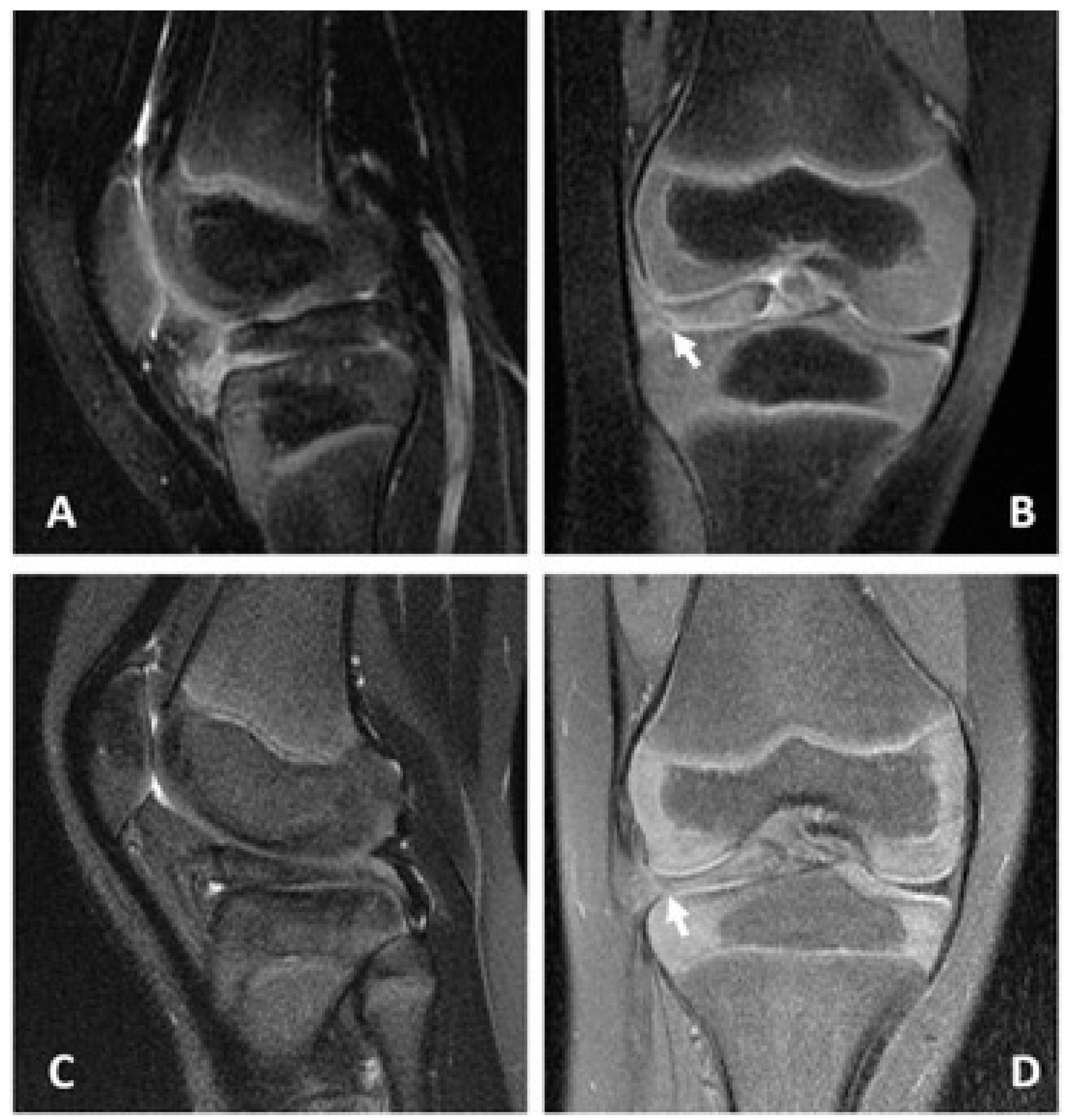Young Children with a Bucket-Handle Tear to the Discoid Lateral Meniscus Successfully Treated Using Arthroscopic Saucerization and Repair: Two Case Reports
Abstract
:1. Introduction
2. Case Report
2.1. Case 1
2.2. Case 2
3. Discussion
4. Conclusions
Supplementary Materials
Author Contributions
Funding
Institutional Review Board Statement
Informed Consent Statement
Data Availability Statement
Acknowledgments
Conflicts of Interest
Abbreviations
References
- Tudisco, C.; Botti, F.; Bisicchia, S. Histological Study of Discoid Lateral Meniscus in Children and Adolescents: Morphogenetic Considerations. Joints 2019, 7, 155–158. [Google Scholar] [CrossRef] [PubMed]
- Yang, X.; Shao, D. Bilateral discoid medial Meniscus: Two case reports. Medicine 2019, 98, e15182. [Google Scholar] [CrossRef] [PubMed]
- Saavedra, M.; Sepúlveda, M.; Jesús Tuca, M.; Birrer, E. Discoid meniscus: Current concepts. EFORT Open. Rev. 2020, 5, 371–379. [Google Scholar] [CrossRef] [PubMed]
- Ahn, J.H.; Shim, J.S.; Hwang, C.H.; Oh, W.H. Discoid lateral meniscus in children: Clinical manifestations and morphology. J. Pediatric. Orthop. 2001, 21, 812–816. [Google Scholar] [CrossRef]
- Yaniv, M.; Blumberg, N. The discoid meniscus. J. Child. Orthop. 2007, 1, 89–96. [Google Scholar] [CrossRef] [PubMed]
- Smillie, I.S. The congenital discoid meniscus. J. Bone Jt. Surg. Br. Vol. 1948, 30, 671–682. [Google Scholar] [CrossRef]
- Ikeuchi, H. Arthroscopic treatment of the discoid lateral meniscus. Tech. Long-Term Results Clin. Orthop. Relat. Res. 1982, 167, 19–28. [Google Scholar]
- Lee, B.-I.; Choi, H.-S. Arthroscopic treatment of symptomatic discoid lateral meniscus in a 26-month-old girl. Arthrosc. J. Arthrosc. Relat. Surg. 2003, 19, 1133–1136. [Google Scholar] [CrossRef] [PubMed]
- Pa, N.; Sc, C. Discoid meniscus. a clinical and pathological study. Clin. Orthop. 1969, 64, 107–113. [Google Scholar]
- Barnes, C.L.; McCarthy, R.E.; VanderSchilden, J.L.; McConnell, J.R.; Nusbickel, F.R. Discoid Lateral Meniscus in a Young Child: Case Report and Review of the Literature. J. Pediatric Orthop. 1988, 8, 707–709. [Google Scholar] [CrossRef] [PubMed]
- Orth, R.C. The pediatric knee. Pediatric. Radiol. 2013, 43, 90–98. [Google Scholar] [CrossRef] [PubMed]
- Li, Y.; Wu, Y.; Zeng, Y.; Gu, D. Biomechanical differences before and after arthroscopic partial meniscectomy in patients with semilunar and discoid lateral meniscus injury. Am. J. Transl. Res. 2020, 12, 2793–2804. [Google Scholar] [PubMed]
- Davidson, D.; Letts, M.; Glasgow, R. Discoid meniscus in children: Treatment and outcome. Can. J. Surg. 2003, 46, 350–358. [Google Scholar] [PubMed]
- Good, C.R.; Green, D.W.; Griffith, M.H.; Valen, A.W.; Widmann, R.F.; Rodeo, S.A. Arthroscopic treatment of symptomatic discoid meniscus in children: Classification, technique, and results. Arthrosc. J. Arthrosc. Relat. Surg. Off. Publ. Arthrosc. Assoc. N. Am. Int. Arthrosc. Assoc. 2007, 23, 157–163. [Google Scholar] [CrossRef] [PubMed]
- Fazio, M.G.; Royston, E.J.; Rooks, V.J. An atypical symptomatic discoid lateral meniscus in a toddler. Radiol. Case Rep. 2013, 8, 828. [Google Scholar] [CrossRef] [PubMed] [Green Version]
- Yoo, W.J.; Jang, W.Y.; Park, M.S.; Chung, C.Y.; Cheon, J.E.; Cho, T.J.; Choi, I.H. Arthroscopic Treatment for Symptomatic Discoid Meniscus in Children: Midterm Outcomes and Prognostic Factors. Arthrosc. J. Arthrosc. Relat. Surg. Off. Publ. Arthrosc. Assoc. N. Am. Int. Arthrosc. Assoc. 2015, 31, 2327–2334. [Google Scholar] [CrossRef] [PubMed]
- Kocher, M.S.; Logan, C.A.; Kramer, D.E. Discoid Lateral Meniscus in Children: Diagnosis, Management, and Outcomes. J. Am. Acad. Orthop. Surg. 2017, 25, 736–743. [Google Scholar] [CrossRef] [PubMed]
- Feroe, A.G.; Hussain, Z.B.; Stupay, K.L.; Kocher, S.D.; Williams, K.A.; Micheli, L.J.; Kocher, M.S. Surgical Management of Medial Discoid Meniscus in Pediatric and Adolescent Patients. J. Pediatric. Orthop. 2021, 41, e804–e809. [Google Scholar] [CrossRef] [PubMed]



Publisher’s Note: MDPI stays neutral with regard to jurisdictional claims in published maps and institutional affiliations. |
© 2022 by the authors. Licensee MDPI, Basel, Switzerland. This article is an open access article distributed under the terms and conditions of the Creative Commons Attribution (CC BY) license (https://creativecommons.org/licenses/by/4.0/).
Share and Cite
Liao, Y.-H.; Chen, C.-H.; Lin, C.-J.; Su, W.-R.; Shih, C.-L.; Chiang, C.-H. Young Children with a Bucket-Handle Tear to the Discoid Lateral Meniscus Successfully Treated Using Arthroscopic Saucerization and Repair: Two Case Reports. Medicina 2022, 58, 1403. https://doi.org/10.3390/medicina58101403
Liao Y-H, Chen C-H, Lin C-J, Su W-R, Shih C-L, Chiang C-H. Young Children with a Bucket-Handle Tear to the Discoid Lateral Meniscus Successfully Treated Using Arthroscopic Saucerization and Repair: Two Case Reports. Medicina. 2022; 58(10):1403. https://doi.org/10.3390/medicina58101403
Chicago/Turabian StyleLiao, Yu-Hsiang, Chun-Ho Chen, Chii-Jeng Lin, Wei-Ren Su, Chia-Lung Shih, and Chen-Hao Chiang. 2022. "Young Children with a Bucket-Handle Tear to the Discoid Lateral Meniscus Successfully Treated Using Arthroscopic Saucerization and Repair: Two Case Reports" Medicina 58, no. 10: 1403. https://doi.org/10.3390/medicina58101403





